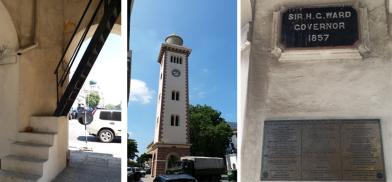Colombo's iconic Lighthouse Clock Tower is a silent sentinel of time
This is the story of the beginning of the oldest clock tower in Asia and the only lighthouse clock tower in the world.

Standing at the very entrance of Chatham Street, one can unmistakably notice the towering Old Lighthouse of Colombo at the other end. A prominent structure build in 1857, today it is a famous tourist attraction. However, very little is known about the only lighthouse clock tower in the world and also the oldest clock tower in Asia.
Its year of construction is 1857, connecting it to a very vital period of history, that saw the beginning of many changes that altered the course of not only local but regional history as well. Today, several of these incidents are also referred to be connected to multiple changes and transformations in various parts of the world.
Standing pristine under the bright Colombo sun, towards dusk the Lighthouse Clock Tower gradually transforms into a silhouetted spectre as the sky behind alters into a many-layered palette under the last rays of the setting sun over the Indian Ocean. Under the grey-blue of the night sky, the building stands, almost like an exclamation mark, precisely dividing Chatham Street into two neat sentences - "I am a witness! Regrettably! - but, remember me as a part of a time from the past." This is the story of the beginning of the oldest clock tower in Asia and the only lighthouse clock tower in the world.
As the busy Chatham Street receives its many footfalls throughout the day, the very juncture of the Old Lighthouse remains relatively empty. One of the reasons could be the very fact that it stands at the entrance to the significant Janadhipathi Mawatha (formerly Queen’s Road), which has the President’s House. Thus, it is also always advisable to refrain from lingering around for minutes together near the monument. However, if one pays a quick visit to the base of the Tower, one would be amazed to see the immediate narration unfolding dating back to more than one and a half centuries.
Clock Tower's historic role
At the very base of the Tower are two plaques. One is short and mentions a dedication- “Sir H.C. Ward, Governor- 1857” and the other is a wide brass plaque, that speaks of a brief history of the Clock Tower in three languages- English, Sinhala and Tamil- “This clock tower, designed by Lady Steinberg Ward and Assistant Engineer of the Public Works Department- Mr. J.F. Churchill, was declared open on 25th march by the Governor of Ceylon- Sri Henry George Ward. The clock bears the date 1814 (making it the oldest clock tower of Asia), probably the date of manufacture. The clock tower had been fitted with light to facilitate sea travellers and had functioned as a lighthouse 96 feet high from 1867- 22nd July 1952. It is the only lighthouse clock tower in the world. It is also the centre from which the distances of the road network throughout Sri Lanka are measured. This historical lighthouse clocktower has been conserved and is maintained by the Central Bank of Sri Lanka since 1999.”
Sir Henry George Ward, became the Governor of Ceylon (the old name for Sri Lanka) on May 11, 1855. Ward helped to consolidate public administration and he was the governor till 1860. His work mainly involved looking after and also helping to improve various public offices, including railways, communications (and the introduction of telegraph), and immigrant labour and each remained connected with the other. Assuming duty at a crucial time, all of Governor Ward’s works changed the course of not only the country of Sri Lanka but the entire region of South Asia. Today, these actions can even be looked at as being related to numerous changes that sparked off simultaneously at various other parts of the world.
This can be better understood through two of Ward’s most important works - helping the then Governor-General of India, Lord Canning, during 1857 and bringing a change in labour laws of Ceylon. Canning requested Ward to assist him with troops from Ceylon to fight the Indian sepoys in northern India in 1857. This has also been recorded in a book by George Dodd, published just two years after the incident. Writes Dodd in 1859, in his ‘The history of the Indian revolt and the expeditions to Persia, China and Japan 1856-7-8- With maps, plans and wood engravings’ in Chapter 10, titled- ‘Bengal and the Lower Ganges’ - “The military proceedings on this occasion were as follow. Before light on Sunday morning the 14th (of June), in consequence of a message received from headquarters, a body of the 78th Highlanders was sent off hastily from Chinsura to Barrackpore, to disarm the native troops there; while five hundred of her Majesty’s 37th foot, landed from Ceylon only the day before, were marched off to a point about midway between Calcutta and Barrackpore, to command the road during the disarming.”
European troops to quell Indian mutiny
Canning wrote to Ward on May 29th, 1857, requesting to assist him with European troops in ‘the mutiny of the sepoys’. Upon hearing from Canning, Ward dispatched all 500 European troops in his colony to Bengal by steamer. Ward had to also inform the office of the Secretary of the State for the Colonies in England. At that time, The Secretary was Henry Labouchere. Paul Fletcher mentions (pp-93) in his ‘The Uses and Limitations of Telegrams in Official Correspondence between Ceylon's Governor General and the Secretary of State for the Colonies, circa 1870-1900’ that Ward wrote to the Secretary, that the Governor-General of India has requested for troops to assist him, asking, “that a portion of the European Regiment situation in Ceylon might be shared temporarily for the purpose of restoring safety to our Indian possessions.” The letter also mentioned that the portion of British troops available in northern India was insufficient to hold back the ‘riotous groups’ (as Canning mentioned in his letter). The letter went on also expressing Ward’s general fear and apprehension about an impending similar situation in Ceylon, if matters were not dealt with forcefully. The letter also mentioned that he was sending 500 troops to India and also has given “considerable sanctions to the police force both at Colombo and Kandy”- for the "ostensible protection of the island" if any untoward situation rose in Ceylon.
Labouchere received Ward’s letter on July 15th – more than one month after Ward wrote from Sri Lanka and after two months since Canning wrote to Ward from India. Thus, all actions were already taken by the time the letter reached Labouchere’s office. This put the Governor of Ceylon and the Secretary of the State for the Colonies at a muted divide as actions were carried out without informing the superior. This divide kept widening as letters delayed several communications across the tenure of Ward’s office and the Governor’s office in Ceylon continued to fight a growing divide with the Secretary of the State, till finally, a solution came in 1870 (though Ward had left by then), with the introduction of telegram. This encouraged communications within a single day between the Governor of Ceylon and the Secretary of State.
Along with being the precursor of changing channels of communication, Ward’s period also witnessed the beginning of a gradual change in labour laws of the colonial land, which changed the history of the country for years to come. Ward, for the first time, began allowing permanent immigrant labourers from India to work in the rubber, coffee and tea plantations in Sri Lanka. These initial attempts stood as mute spectators to witness the beginning of a saga of planned exploitation and mistreatment, throwing generations into uncertainty and despicable conditions of life and living. The story of this began in the first quarter of the 19th century and this needs to be understood through the channels of coffee plantations in Sri Lanka under British colonial rule. Mentions K.T. Rajasingham in ‘Sri Lanka- The untold story’ (Chapter-13), by 1837, there were 4000 acres of land under coffee plantations under the British in Sri Lanka. By 1860, it was 40,000, which increased to 250,000 by 1845 and by 1878, it reached its maximum at 773,000 acres.
However, by end of the 1870s, a deadly fungus Hemileia Vastratrix appeared, leading to a massive spread of a contagious disease amongst the coffee plants. This resulted in plummeting coffee production. Initially, the immigrants, who were brought to work in the coffee plantations from India, were seasonal and returned to India after the season of picking the coffee beans was over. However, the situation changed by the time Henry Ward assumed office because by then, there was a growing need for permanent labourers to work in the already thriving rubber plantations and slowly-becoming popular tea gardens, alongside the coffee plantations.
Also, the production of tea rapidly increased after the 1870s as coffee production fell. This growth in tea is reflected variously by contemporary merchants. Mentions Gow, Wilson and Stanton, tea and tea share-brokers in March 1897 in their book ‘Tea producing companies of India and Ceylon’ (pp-iv)- “Regarding the recent developments and present position of the Tea Trade, …. British-grown tea has, during the last 30 years, displaced former sources of supply. For 1896, the home consumption of British-grown tea has been 89 per cent, and that of China and other teas only 11 per cent., to contrast with consumption in 1868 of but 7 per cent, of British-grown tea and 93 per cent, of China and other tea.”
By the time Ward came to office, he saw an imminent need to increase the recruitment of permanent Indian labourers in the fields thus. The story of getting labourers from India changed thereafter. This became more prominent when the labour law in 1873 was passed (though Ward had left by then), which allowed the immigration of Indian labourers.
Old Lighthouse deactivated
Finally, associated with the flourishing rubber and tea and primarily coffee trade, in December 1856, Ward gave instructions to Captain William Scarth Moorsom, the Chief Engineer of the Corps of Royal Engineers, to undertake and produce a detailed report on the provision of a rail link from Colombo to Kandy. This report, corresponding with the period of the beginning of the work of the Clock Tower, came out in May 1857 and recommended six possible routes and one major one, which was via the Parnepettia Pass, with a total length of 126 km.
In June 1860, Ward was appointed as Governor of Madras and succeed Sir Charles Trevelyan, but only served in the office for a mere few weeks as he contracted cholera and breathed his last from it on August 2, aged 63. He lies buried at St. Mary’s Church in Chennai.
The Old Lighthouse, on the other hand, was deactivated when the light became obscured by nearby buildings. In 1952, the current 29-metre-high Lighthouse was built as part of the Colombo Harbour Expansion project. It was inaugurated by Don Stephan Senanayake, the first Prime Minister of Ceylon.
Thus, nearly a century after it began its journey, the Lighthouse was left to probably continue its initial work - to keep time. Indeed, it might have witnessed and signaled off the steamer that left with 500 British troops for Bengal in 1857, or witnessed the many sea travellers who were brought in to work in the various plantations, many of whom returned home, while many others did not.
“The hours of folly are measured by the clock; but of wisdom, no clock can measure.’’ (William Blake). Indeed, Colombo's iconic Clock Tower is not just the oldest in Asia but stands as a sage sentinel of time.
(The author is an Indian academic, author and columnist. Views are personal. She can be reached at lopamudramaitra@gmail.com)










Post a Comment